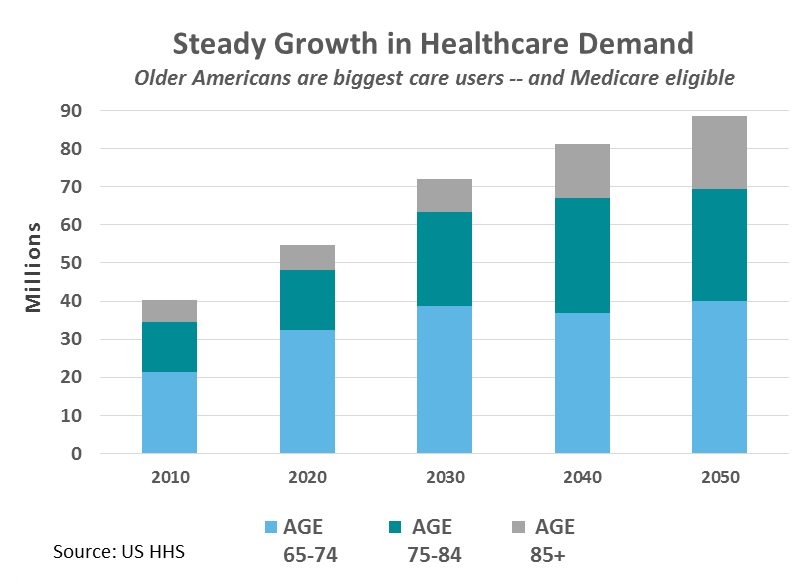
Healthcare Industry Forecast: High Demand Due to Aging, Economy
Despite the back and forth in Congress over healthcare policy, the industry’s very strong positives continue to shine. The best evidence is that healthcare continues to be one of the strongest employment sectors in our economy.
In the first three months of 2017, during a time when the media was full of stories about imminent change and uncertainty for the industry, healthcare still added approximately 60,000 new jobs. Demand for healthcare services -- and for nurses, physicians, allied professionals, leaders and many nonclinical roles -- remains high and will continue to grow.
Most Powerful Driver: Aging
The greatest driver of healthcare demand is the aging of the American populace, or, another way of putting it, the steady expansion of the population that uses the most healthcare and receives universal coverage through Medicare. People over the age of 65 experience three times more hospital days than the general public, while those over 75 have four times more days, according to the U.S. Centers for Disease Control.

From 2010 to 2050, this strategic population for the healthcare industry will more than double – increasing by nearly 50 million, according to the US Department of Health and Human Services. Many healthcare policies will change in that time period, but the demand for care will steadily grow as this population grows. And their care is covered.
More Employment, More Healthcare Demand
Another macro-trend driving healthcare demand is the economy. Our growing economy means more people have jobs with insurance, and more money in their pockets for copays and deductibles. Total U.S. employment will rise from 150.5 million in 2014 to 160.3 million in 2024, according to the U.S. Bureau of Labor Statistics. While not all of these nearly 10 million new workers will have healthcare coverage, many will while others will have some resources to seek healthcare.
At the same time that patient demand is rising, shortages exist across the country for nurses, physicians and allied health professionals in virtually all specialties. The gap of unfilled healthcare jobs is huge. And, our clinical workforce is getting older, and more practitioners are retiring or going to part-time.
Uber-Competitive Environment
Rising patient demand and shortages of healthcare professionals are occurring in an environment of intense competition among providers and abundant job opportunities for practitioners. The consolidation of hospitals, health systems and other healthcare facilities is creating sophisticated Fortune 500-type companies that require quality, well-trained clinical and leadership professionals who can thrive in this advanced industry environment.
At the same time, the ongoing shortages of all types of healthcare professionals has created an uber-competitive talent acquisition environment. In December, the US Bureau of Labor Statistics tallied approximately a half million open jobs in healthcare. Quality clinicians find many occupational opportunities to choose from, and even those not looking for jobs are receiving good offers.
The result of these realities is a healthcare industry more vibrant than ever, one that will continue to grow for the foreseeable future -- regardless of the current political narrative.


